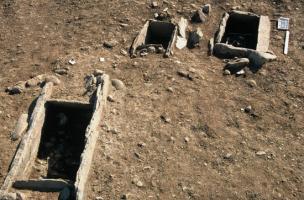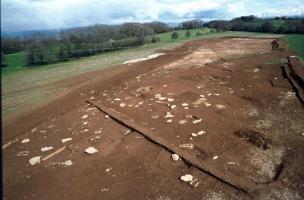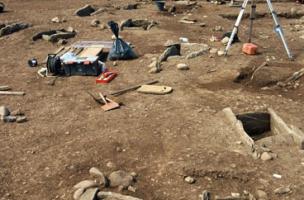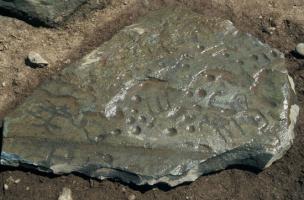Search
You are here
A Neolithic cemetery of major importance for both French and Swiss archaeology
In 2002, the National Institute for Preventive Archaeology (INRAP) discovered the Genevray site on the route of the future Thonon-les-Bains bypass in Haute-Savoie. An evaluation was authorised and curated by the archaeology service of the DRAC de Rhônes-Alpes.
Chronicle of site
Post date
20 July 2004
Last modified
13 February 2017
Given the importance of the discoveries and the impact of the road project, the curator decided on full excavation by an INRAP team. This began last February, an area of 26,000 m2 being opened. There followed the discovery of a vast completely preserved Middle Neolithic cemetery of a type hitherto unknown in France. It contains more than 150 graves dated for the most part from the middle of the fifth millennium to the end of the fourth millennium BC (± 4500-3300 BC).
Graves and cist burials
Two kinds of graves are to be found in the cemetery. There are at least thirty-five simple pit graves which may have contained wooden coffins. In addition, there are one hundred and fifteen stone-lined cist graves. These comprise four or six side stones sealed by a covering slab sometimes of imposing dimensions. Many of these cists can be considered to be small vaults. During the Neolithic period, the covers were visible at ground level. Most of them stuck out while others barely showed on the surface. A very few were completely buried, the grave being indicated by the presence of one or two small standing slabs. The bases, erect but broken at ground level are still in place at the periphery of the cemetery. Some of them may have been sculpted as is indicated by the many fragments re-used in the cist graves as covers or side stones.
Some blocks and stones which probably came from the Neolithic cemetery, were found strewn on the ground or in late Bronze Age pits (1000-800 BC).
Single and Multiple Graves
The bodies lie on the left side in the foetal position or lie supine with the head towards the East. In some cist graves, the position of the body is strongly contracted. The simple graves (only two have been excavated so far), seem to contain only one individual, whereas in the cist graves there can be one, two or several individuals (six is the maximum known for the moment). The objects that accompany the deceased are for the main part in stone, bone or shell. When there is multiple occupation it is possible to distinguish between successive and simultaneous burial thanks to detailed on-site anthropological analysis.
A major discovery for both French and Swiss archaeology
The relative chronological relationship between the simple graves and cist graves is not yet completely understood. In the Lausanne-Vidy cemetery on the Swiss shore of Lake Léman the cists are the earliest graves. It remains to be seen whether sequence is the same at Thonon-les-Bains, where a simple grave contained a pottery vessel.
As for the cist graves installed at the bottom of large graves they are known as Chamblandes cists (after the site of the same name located in the region of Vaud on the Swiss shore of lake Léman).
The Genevray cemetery fits into a general trend towards collective burial. Individual burial, as far as we can tell, begins to be superseded by multiple burial which goes on to dominate the late Neolithic period. This new style collective burial spreads throughout western Europe taking on a monumental form. Research at this site presents a great opportunity to increase our knowledge about the different cultural traditions that surround mortuary rituals during the sixth to fourth millennia BC in the centre-east of France and in nearby areas.
As for the cist graves installed at the bottom of large graves they are known as Chamblandes cists (after the site of the same name located in the region of Vaud on the Swiss shore of lake Léman).
The Genevray cemetery fits into a general trend towards collective burial. Individual burial, as far as we can tell, begins to be superseded by multiple burial which goes on to dominate the late Neolithic period. This new style collective burial spreads throughout western Europe taking on a monumental form. Research at this site presents a great opportunity to increase our knowledge about the different cultural traditions that surround mortuary rituals during the sixth to fourth millennia BC in the centre-east of France and in nearby areas.
Roadworks
The 8km-long bypass will cross the districts of Margencel, Anthy, Thonon-les-Bains and Alinges and divert traffic from the centre of Thonon-les-Bains. It consists of 5 interchanges, numerous bridges, a viaduct, important earthworks and sound barriers.
The work will be carried out by the Haute-Savoie regional council with the financial support of the Inter-communal Association for the Development of Chablais (SIAC) and the Rhône-Alpes regional council. Preliminary studies have made headway, and planning consent was given by the prefect in mid-June 2004. Construction will probably begin in the first quarter of 2005.
The work will be carried out by the Haute-Savoie regional council with the financial support of the Inter-communal Association for the Development of Chablais (SIAC) and the Rhône-Alpes regional council. Preliminary studies have made headway, and planning consent was given by the prefect in mid-June 2004. Construction will probably begin in the first quarter of 2005.

Nécropole néolithique de Thonon-les-Bains
Trois sépultures en coffre
Trois sépultures en coffre
© L. de Cargouët / Inrap

Nécropole néolithique de Thonon-les-Bains
Vue aérienne de la nécropole
Vue aérienne de la nécropole
© L. de Cargouët / Inrap

Nécropole néolithique de Thonon-les-Bains
Fouille d'une tombe à l'aspirateur
Fouille d'une tombe à l'aspirateur
© L. de Cargouët / Inrap

Nécropole néolithique de Thonon-les-Bains
Vue du chantier en cours de fouille
Vue du chantier en cours de fouille
© L. de Cargouët / Inrap

Nécropole néolithique de Thonon-les-Bains
Vue de deux tombes en coffres
Vue de deux tombes en coffres
© L. de Cargouët / Inrap

Nécropole néolithique de Thonon-les-Bains
Relevé d'un tombe en coffre
Relevé d'un tombe en coffre
© L. de Cargouët / Inrap

Nécropole néolithique de Thonon-les-Bains
Pierre à cupules
Pierre à cupules
© L. de Cargouët / Inrap

Nécropole néolithique de Thonon-les-Bains
Détail d'une sépulture en coffre avec deux individus
Détail d'une sépulture en coffre avec deux individus
© L. de Cargouët / Inrap
Archéologue responsable d'opération : Dominique Baudais (Inrap)
Contrôle scientifique : Direction régionale des Affaires culturelles de Rhône-Alpes/service régional de l'Archéologie
Aménageur : Conseil général de Haute-Savoie/SED
Contact(s) :
Mahaut Tyrrell
Media communication
Inrap, media partnerships and relations
+33 6 07 40 59 77
mahaut.tyrrell [at] inrap.fr

